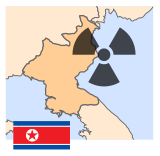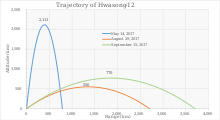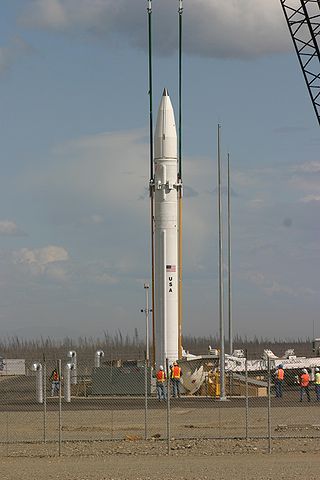
An anti-ballistic missile (ABM) is a surface-to-air missile designed to counter ballistic missiles. Ballistic missiles are used to deliver nuclear, chemical, biological, or conventional warheads in a ballistic flight trajectory. The term "anti-ballistic missile" is a generic term conveying a system designed to intercept and destroy any type of ballistic threat; however, it is commonly used for systems specifically designed to counter intercontinental ballistic missiles (ICBMs).

An intercontinental ballistic missile (ICBM) is a ballistic missile with a range greater than 5,500 kilometres (3,400 mi), primarily designed for nuclear weapons delivery. Conventional, chemical, and biological weapons can also be delivered with varying effectiveness, but have never been deployed on ICBMs. Most modern designs support multiple independently targetable reentry vehicle (MIRVs), allowing a single missile to carry several warheads, each of which can strike a different target. The United States, Russia, China, France, India, the United Kingdom, Israel, and North Korea are the only countries known to have operational ICBMs.
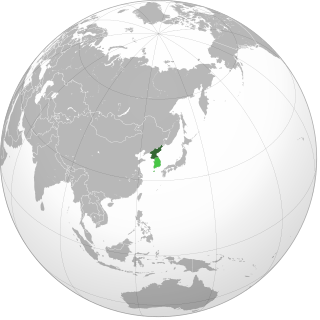
North Korea has a military nuclear weapons program and, as of early 2020, is estimated to have an arsenal of approximately 30 to 40 nuclear weapons and sufficient production of fissile material for six to seven nuclear weapons per year. North Korea has also stockpiled a significant quantity of chemical and biological weapons. In 2003, North Korea withdrew from the Treaty on the Non-Proliferation of Nuclear Weapons (NPT). Since 2006, the country has conducted six nuclear tests at increasing levels of expertise, prompting the imposition of sanctions.
The Hwasong-7, also known as Nodong-1, is a single-stage, mobile liquid propellant medium-range ballistic missile developed by North Korea. Developed in the mid-1980s, it is a scaled up adaptation of the Soviet R-17 Elbrus missiles, more commonly known by its NATO reporting name "Scud". Inventory is estimated to be around 200–300 missiles. US Air Force National Air and Space Intelligence Center estimates that as of June 2017 fewer than 100 launchers were operationally deployed.

Terminal High Altitude Area Defense (THAAD), formerly Theater High Altitude Area Defense, is an American anti-ballistic missile defense system designed to shoot down short, medium, and intermediate-range ballistic missiles in their terminal phase by intercepting with a hit-to-kill approach. THAAD was developed after the experience of Iraq's Scud missile attacks during the Gulf War in 1991. The THAAD interceptor carries no warhead, instead relying on its kinetic energy of impact to destroy the incoming missile.

The Korean People's Army Strategic Force, previously known as the Korean People's Army Strategic Rocket Force and as the Missile Guidance Bureau, is a military branch of the Korean People's Army that oversees North Korea's nuclear and conventional strategic missiles. It is mainly armed with surface-to-surface missiles of domestic design as well as older Soviet and Chinese models. The KPA Strategic Force was established in 1999 when several missile units under KPA Ground Force Artillery Command were re-organized into a single missile force reporting directly to the office of the Supreme Commander of the KPA via the General Staff.
The Hwasong-10, also known by the names BM-25 and Musudan, is a mobile intermediate-range ballistic missile developed by North Korea. Hwasong-10 was first revealed to the international community in a military parade on 10 October 2010 celebrating the Workers' Party of Korea's 65th anniversary, although experts believe these were mock-ups of the missile. Hwasong-10 resembles the shape of the Soviet Union's R-27 Zyb submarine-launched missile, but is slightly longer. It is based on the R-27, which uses a 4D10 engine propelled by unsymmetrical dimethylhydrazine (UDMH) and nitrogen tetroxide (NTO). These propellants are much more advanced than the kerosene compounds used in North Korea's Scuds and Nodong missiles.
This is a comparison list of intercontinental ballistic missiles developed by various countries.
The Hwasong-13, also known as Nodong-C or KN-08 under the U.S. naming convention, is a road-mobile intercontinental ballistic missile believed to be under development by North Korea. The changes shown in the mock-up displayed in October 2015 indicated a change from a three to two-stage design.
The KN-02 Toksa, Hwasong-11 is a North Korean reverse-engineered locally produced modification of the OTR-21 Tochka short-range ballistic missile.

The Hwasong-12 is a mobile intermediate-range ballistic missile developed by North Korea. The Hwasong-12 was first revealed to the international community in a military parade on 14 April 2017 celebrating the Day of the Sun which is the birthday anniversary of North Korea's founding President, Kim Il Sung. North Korea tested Hwasong-12 on 30 January 2022.
The Hwasong-14, also known under alternative US designation codename KN-20, is a mobile intercontinental ballistic missile developed by North Korea. It had its maiden flight on 4 July 2017, which coincided with the United States' Independence Day. North Korea is the only known operator of this missile.
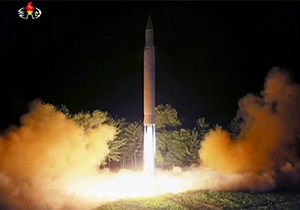
The 2017–2018 North Korea crisis was a period of heightened tension between North Korea and the United States throughout 2017. The crisis began early in 2017 when North Korea conducted a series of missile and nuclear tests that demonstrated the country's ability to launch ballistic missiles beyond its immediate region, suggesting their nuclear weapons capability was developing at a faster rate than had been assessed by U.S. intelligence. Both countries started exchanging increasingly heated rhetoric, including nuclear threats and personal attacks between the two leaders, which, compounded by a joint U.S.–South Korea military exercise undertaken in August and North Korea's sixth nuclear test in September, raised international tensions in the region and beyond and stoked fears about a possible nuclear conflict between the two nations. In addition, North Korea also threatened Australia twice with nuclear strikes throughout the year for their allegiance with the United States.
The Hwasong-15 is an intercontinental ballistic missile developed by North Korea. It had its maiden flight on 28 November 2017, around 3 a.m. local time. It is the first ballistic missile developed by North Korea that is theoretically capable of reaching all of the United States' mainland.
KN-23, officially the Hwasong-11Ga 《화성-11가》형 is a designation given to a North Korean solid-fueled tactical ballistic missile.
The Hwasong-17 is a North Korean two-stage ICBM, first unveiled on 10 October 2020, the 75th anniversary of the founding of the Workers' Party of Korea (WPK) parade. The Japanese Ministry of Defence estimates its operational range at 15,000 km or more. Unlike its predecessors, the Hwasong-17 may be capable of carrying multiple warheads. North Korea claimed the first Hwasong-17 was successfully launched on 24 March 2022. Western analysts instead believe the 24 March launch was an earlier missile design, and a later test that took place on 18 November 2022 was the first successful test launch.

The 2021–2023 North Korean missile tests are a series of North Korean missile tests in 2021, 2022, and 2023. North Korea conducted a record number of tests in 2022, including the first test over Japanese territory since 2017.
The Hwasong-8 is a North Korean missile claimed to be mounting a hypersonic glide vehicle, which was first tested on 14 September 2021. The first launch occurred in September, in a month with a total of four missile launches. As it is supposed to be a hypersonic missile, the missile significantly increases the threat that North Korea can put on South Korea, as the higher speed allows it to reach its target in shorter time and additional maneuverability would give it a better chance at defeating missile defenses. Japanese tracking data from a test launch suggest it is a hypersonic ballistic missile, as North Korea described it.

The Hwasong-18 is a North Korean three-stage solid-fuelled intercontinental ballistic missile (ICBM). It is the first solid-fuelled ICBM developed by North Korea, and was first unveiled at the 8 February 2023 parade commemorating the 75th anniversary of the founding of the Korean People's Army. Its maiden flight occurred on 13 April 2023.
